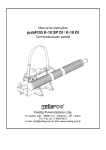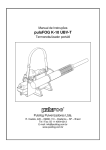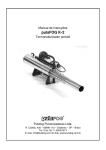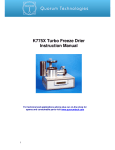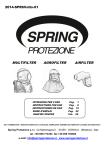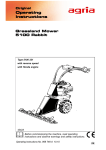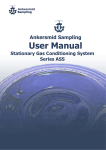Download Operating Instructions pulsFOG K-10 SP • K-10 Standard • K
Transcript
Operating Instructions pulsFOG K-10 SP • K-10 Standard • K-10/O Portable Thermal Fogger Dr. Stahl & Sohn GmbH Abigstrasse 8 · D-88662 Überlingen/Germany Tel: ++49 7551 9261 0 Fax: ++49 7551 9261 61 E-Mail: [email protected] 1. SAFETY INSTRUCTIONS AND ACCIDENT PREVENTION Warning: Read, understand and respect these safety precautions before operating machine. Failure may lead to a fire hazard. Operator must be trained by pulsFOG authorized personnel. • • • • • • • • • • • • • • • • • • • Check the functional safety of the unit each time before using it. For stationary operation, ensure safe standing for the unit. Never fill in fuel when the unit is hot! Never fill fuel into the solution tank! When filling one of the tanks or when inspecting the carburettor, smoking is prohibited in the immediate environment. Never let the unit run without supervision. Operator shall close the fogging tap immediately after sudden stop of engine. Do not fog in rooms where there is a danger of dust explosion. (e.g. grain mills) Do not fog directly into a pipe with a similar diameter as the fogging pipe of the unit (cooling effect of the unit is interrupted and a combustible concentration of aerosols may occur). Do not fog with combustible liquids into pipes or tunnels without ventilation (except with BlO-units ) because of fire and explosion hazard. Do not fog any liquids with a flash point of less than 75 ° C. For fogging inflammable products, only use „O” series units or „BIO” series units with separate water injection (e.g. K-10/O or K-22 BIO) equipped with automatic cut off device for the fogging solution. Never fog more than 2,5 Itr. of an oilbased or similar inflammable liquid into an enclosed space of 1000 m3 and never more than 10 Itr. of a waterbased liquid (with less of 50% water) into a space of 1000 m3 or another corresponding amount of liquid in a corresponding space volume. If a combustible atmosphere is established a source of ignition may cause fire (e.g. electric sparks). Therefore such sources have to be eliminated or turned off. When fogging liquids with a possible fire hazard (e.g. oils, alcohols ....) a fire extinguisher shall be provided near the unit. Do not transport hot units in enclosed vehicles. Never ship the unit with fuel or agent in the tank. If there is still fuel in the tank during transportation, the unit must be upright and secured against tilting. Do not touch the fogging pipe while the engine is running and up to 30 min after run. Do not touch the protection jacket (cooling jacket) for 30 minutes after stopping the engine (danger of injury due to radiated heat)! Eliminate any leakage occurring on the unit without delay. Have the unit checked regularly by a suitable qualified technician able to service it in accordance with the safety rules and the accident preventive regulations or at the manufacturer's service workshop. Observe the instructions for use supplied by the pesticide manufacturer. When fogging, use protective equipment such as protective clothing, gas mask, protective gloves and ear protectors as applicable. The type and quality of the protective equipment to be used depend on the national legal obligations. In Europe the filter for the gas mask (full-face mask) must meet the protection category A2 B2-P3 as a minimum requirement. 2. SPECIFICATIONS pulsFOG type: Dimensions Empty weight Gross weight (filled tanks) Capacity of chemical tank Capacity of fuel tank Starting current (4x1,5 V cells) Combustion chamber volume Gross max. power of engine Max. fuel consumption Flow rate with 0,8 nozzle Operating pressure in chemical tank Max. sound pressure level during fogging Operating temperature* (ambient air temperature 20 ° C) on cooling jacket, max. Temperature on cooling jacket 10 minutes after engine stop Temperature of combustion gas at resonator outlet when idling OPTIONAL EQUIPMENT ACCESSORIES RECOMMENDED ACCESSORIES SPARE PARTS * measured during fogging K-10/O K-10 Standard K-10 SP 129x30x36 cm 106x29x33 cm 8,5 kg 7 kg 19,5 kg 13,5 kg 9 Itr. 5 Itr. 2 Itr. 2 Itr. 6 V DC 6 V DC 300 cm³ 300 cm³ 17,5 kW/24,1 h.p./15300 kcal/h 1,9 Itr./h 1,9 Itr./h see 7.2 0,2-0,35 bar 0,2-0,35 bar 98 db 98 db 35 ° C 35 ° C 120 ° C 120 ° C 550 ° C 550 ° C Automatic cut off device for inflammable fogging solutions Extralong protective grating Flame head Air-agitator Funnel for chemicals Fuel pitcher Cleaning brush for resonator Ear protectors Protective clothing Gas mask with filter A2B2P3 Horticultural kit cpl. consisting of: Bucket 10 ltr., 2 stirring sticks, Measure 2 ltr. Measure 0,25 ltr. Spare parts set with gaskets and diaphragms Subject to technical changes pulsFOG K-10 SP • K-10 Standard • K-10/O Portable thermal foggers, type K-10 SP and K-10/O suitable for use in greenhouses, storerooms, warehouses and livestock buildings with suitable fogging solutions. K-10/O type not suitable for wettable powder formulations. Portable thermal fogger, type K-10 Standard suitable for use in greenhouses with waterbased, non flammable fogging solutions. 3. SUMMARY OF OPERATION 3.1 Preparations a) Fill the fuel tank completely using the pulsFOG fuel pitcher (1,8 Itr. max.). Close the lid tightly. b) Remove the solution tank and fill in the solution to be fogged using the red solution funnel. c) Remount the solution tank to the unit and firmly tighten the lid with the passage. d) Close the fog tap. 3.2 Starting the engine a) Open the adjustable screw on the carburettor by up to 1/3 - 1/2 turn (with the unit heated up, 1/3 of a turn only). b) Press the primer slowly several times with your left and flat hand until the engine starts (pump no more than 5 times). If the engine does not start after having pumped 5 times, open the fuel tank lid and continue pumping until the engine starts. Close the lid. c) After starting the engine, turn the adjustable screw on the carburettor (usually it requires slight opening) so that a powerful, deep engine sound is obtained. (Avoid high frequency engine-run). 3.3 Fogging With the engine running, open the fog tap: The unit starts fogging. 3.4 Interrupting the fogging process With the engine running, close the fog tap, re-open as necessary. 3.5 Stopping the fogging process (proceed in the following order): 1) With the engine running, loosen the chemical tank lid (pressure is released). 2) Close the fog tap by hand. Close the chemical tank lid. 3) Stop the engine (close the adjustable screw on the carburettor). 3.6 Posterior action Let the unit cool down, rinse the solution tank with water or cleaning oil and fog briefly. 4. TECHNICAL DESCRIPTION The unit works according to the pulse-jet principle without any mechanically moving parts. When pressing on the primer or starting button, a fuel/air mixture is produced in the carburettor, blown into the combustion chamber and ignited by the spark plug. A pulsating combustion forms at approximately 80 – 100 explosions per second, controlled by an air diaphragm valve and a fuel adjustable screw on the carburettor. A limited overpressure of 0,2 – 0,35 bar is redirected from the carburettor to the chemical tank through a non-return valve. The pressure in the chemical tank conveys the fogging liquid through an ON/OFF valve and a dosing nozzle to the end of the exhaust pipe. There it is injected into the exhaust stream coming from the combustion chamber. For a fraction of a second (0,05 – 0,1 s), kinetic and thermal energy (600 – 700 kcal/litre of fogging liquid) acts on the injected solution, which is thereby torn to ultra-fine aerosols. The liquid partially vaporizes and converts into a visible fog by immediate condensation in the relatively cool ambient air. 5. PREPARATIONS FOR STARTING 5.1 Fill the fuel tank with pure common petrol (gasoline) of normal grade (also unleaded); avoid supergrade fuel, if possible. The maximum filling capacity is sufficient for emptying the chemical tank. When filling in fuel, always use the graduated fuel pitcher with sieve. Warning: Never start a fogging process with the tank less than half filled. If fuel temperature is less than 10 ° C the engine may start but without powerful run. Allow the fuel to warm up to room temperature. filling the fuel tank 5.2 Run the engine briefly and stop it again (see 6.0). If the tank is less than 1 /4 full, you should avoid sudden movements with the unit as far as possible and not exceed an angle of 45 upwards or downwards. 5.3 Fill the chemical tank as follows: Open the tank lid, remove the tube from the tank and hang it over the dosing nozzle on the fogging pipe. Release the tank holding strap and remove the chemical tank with the opening pointing upwards. The tank may only be filled with a maximum of 9 Itr. of fogging solution (K-10 SP = 4,5 ltr.). Use the funnel with sieve for filling. After filling, close tank with lid. Remount solution tank to the unit. Remove lid. Refix lid with passage and laminate gasket. detaching the chemical tank Warning Viton hoses are not resistant to chemicals containing dichlorvos (DDVP) or Aceton as solvent. Use in that case the yellow Novoprene hoses from pulsFOG. filling the chemical tank 5.4 Check tightness of dosing nozzle Warning: Toxic chemicals of fogging solution may be sprayed by tank pressure onto your body and face if dosing nozzle is not well sealed. 6. STARTING THE ENGINE a) Set the fog tap to the closed position. b) Open the fuel adjustable screw on the carburettor to the starting position (approx. 1/3 to 1/2 turn). Warning: a) set the fog tap to the closed position Opening too far would feed excessive fuel to the engine, which would cause engine and carburettor choking (flooding). Read 6.2 c. c) With your left hand press the primer slowly down several times and each time keep it pressed for some seconds to prolong the ignition. Do not pump more than 5 times. Read 6.2 c. Warning With the fuel tank full, do not press the primer powerfully since this would cause carburettor flooding (excessive fuel injected). Read 6.2 c b) open fuel adjustable screw 1 /2 turn cold engine, 1/3 turn hot engine 6.1 Adjusting for continuous operation After the engine has started and warmed up (approx. 1/2 minute), readjust the adjustable screw on the carburettor (usually, open further) until the engine runs with a powerful, deep sound (low frequency = optimum performance). Warning: A high sound (high-frequency engine run) means poor engine performance which causes overheating and an excessively large droplet spectrum. c) press primer slowly 6.2 If the engine does not start: a) Check the fuel supply, i.e. fuel must be visible in the transparent tube above the red fuel valve (No. 7980); if this is not the case, continue pumping until fuel becomes visible. Even if no fuel becomes visible the red fuel valve may be blocked (moving part sticks). Disassemble the valve and blow with the mouth through (respect arrow direction). Also the fuel filter inside the tank may be choked. a) b) Check spark plug and clean it. fuel visible in the transparent tube c) If the carburettor is flooded (pumped too strongly or too often), proceed as follows: Loosen the fuel tank lid and continue pumping (i.e. blow through and dry the carburettor) until the engine starts, or single explosions occur. When the engine runs, close the fuel tank lid. Reason: If the tank lid is not hermetically closed, the overpressure created by pumping escapes, and no fresh fuel is injected into the carburettor. On the other hand, fresh air is supplied which gasefies the excessive fuel. Since the ignition is also actuated with each pumping operation, the unit starts immediately as soon as the carburettor is sufficiently dry and an ignitable mixture has formed. Warning: Do not forget to close the fuel tank lid again! c) open fuel tank lid and pump again 7. FOGGING Open the fog tap. The unit starts fogging immediately. Note: The engine frequency may now vary slightly under load. In this case, readjust the adjustable screw on the carburettor once more (usually, open a little more). 7.1 Interrupting the fogging process With the engine running, close the fog tap; re-open as necessary. fogging: open the fog tap Warning: For short interruptions (1/2 minute), it is not necessary to stop the engine. Warning: Towards the end of the fogging process, usually there is only little fuel left in the tank. Therefore you should avoid sudden movements in order to prevent air from being taken in by the fuel suction piece. A single air bubble may cause engine standstill. This may lead to a fire hazard if unit is not equipped with an automatic cut- off device for the fogging solution or if operator forgets to shut immediately the fog tap. 7.2 Flow rate and droplet size are controlled by interchangeable dosing nozzles. The flow rate depends on the unit type, the set power of the motor and the viscosity of the liquid. This should be checked on a case-to-case basis. i interchangeable dosing nozzle Flow rate with dosing nozzle size 0,8 mm with automatic cut-off device Flow rate with dosing nozzle size 0,8 mm without automatic cut-off device Fogging solution: diesel-oil 10 l/h Fogging solution: water 9 l/h 13,5 l/h 13 l/h 7.3 Stopping the fogging process Proceed in the following order: a) Loosen the lid of the chemical tank (release pressure) and wait until the unit stops fogging. b) Close the fog tap. c) Stop the engine (by closing the adjustable screw on the carburettor). Warning: When you have finished fogging, always release the solution tank from pressure first and close the fog tap before stopping the engine. a) loosen the lid of chemical tank (release pressure) Never stop the engine before the fog tap is closed. Reason: (In case the unit is not equipped with an automatic cut off device.) If you stop the engine before having closed the fog tap, the fogging solution remaining in the tank continues to flow to the very hot fogging pipe where it may cause fire hazard or form black sooty clouds causing dirt on the spark plug and in the carburettor. Venting the solution tank by releasing the tank lid before stopping the engine offers the additional advantage that the liquid still present in the fog solution conduits fogged off and does not remain in the conduits. b) close the fog tap before stopping the engine Warning: Refill fuel only with the unit cooled down. The heat radiation after stopping the engine will heat up the double cooling jacket of the fogging tube. Do not touch the unit for approx. 20 minutes. c) close adjustable screw to stop the engine 8. CLEANING 8.1 The unit must be cleaned after each fogging application. For this purpose, remove the solution tank and rinse it with water. Subsequently, fog approx. 1 Itr. of clear water in order to clean the fog solution conduit. Adding a small quantity of alcohol or just a few drops of dishwashing agent is helpful. 8.2 Final cleaning As described in section 10.1, but with additional cleaning of the carburettor diaphragm, since some fog usually penetrates the carburettor during a fogging application and may cause blocking. The carburettor diaphragm can be cleaned as follows: a) Unscrew the diaphragm valve and blow through from both sides with compressed air. b) Unscrew the diaphragm valve and rinse in hot water (approx. 60 ° C). c) Unscrew the diaphragm valve and rinse with hand-warm water to which cleaning alcohol has been added. Cleaning with water and alcohol is especially recommended after fogging with formalin. d) Unscrew the diaphragm valve and put it into a vessel with fuel for 5 minutes. air. 9. Subsequently dry it with compressed STORAGE If you want to keep residual quantities for a short time in the solution tank, remove the suction tube from the tank. When the unit is not going to be used for some time, drain the fuel tank and store the unit in a cool and clean condition in the cardboard packaging. If you use the unit weekly, refill the fuel tank completely after the unit has cooled down and store it in a safe place, protected against tilting or falling down. The formation of condensate is prevented by the tank being either completely full or completely empty! Warning Condensation in the fuel tank causes considerable malfunctions since the fuel suction piece (No. 169z) and the red fuel valve (No. 7980) will clog. Only store the unit in a dry and cool place, protected from direct sunlight and dust. 10. MAINTENANCE a) 10.1 Cleaning the fogging pipe After fogging critical agents, or every 10 hours of operation at the latest, the resonator (exhaust pipe) should be cleaned with the cleaning brush. b) For this purpose, the cleaning brush must be inserted into the combustion chamber over its full length and then pulled again. For the K-10 model, this is facilitated by unscrewing the nozzle cane (Ref.No. 151) a little. c) 10.2 Servicing After 50 hours of engine operation, replace the diaphragm (no. 72) on the carburettor. Trouble Shooting Fault Identified: Possible Cause: 1. pulsFOG engine does not start No fuel Fuel tank is empty No fuel Adjustable screw is closed No fuel reaches the Fuel nozzle is choked carburettor when pressing the primer No fuel is visible in Fuel valve sticks or is choked the transparent hose Fuel filter is choked between fuel valve and carburettor Fuel in the transparent Red fuel valve not tight hose flows back after Fuel valve dirty pumping No ignition spark at Batteries corroded or empty, the spark plug spark plug defective or wet/dirty ignition coil defect Micro-switch defective No contact between spark plug and spark plug socket No correct air supply through the membrane-valve Membrane (72) is dirty and/or pasted up or assembled incorrectly 2. pulsFOG engine has bad running behaviour Air bubbles in the fuel Fuel pipes or fuel valve leak Fuel supply to the carburettor is not sufficient Adjustable screw incorrectly adjusted Air does not pass at the right measure Membrane (72) is dirty and/or pasted up or assembled incorrectly Remedy: Fill fuel tank Open adjustable screw Clean fuel nozzle and/or blow through ring slot nozzle Blow through or exchange the fuel valve Exchange fuel valve or try to clean it by low air pressure Replace batteries, exchange spark plug resp. dry/clean it. Space between electrodes of spark plug = 1 mm. Replace micro-switch/ ignition coil Fix the high-tension cable to the spark plug socket Assemble cleaned membrane-valve correctly (see drawing) Tighten fuel pipes and exchange fuel valve Turn adjustable screw to the left until the engine runs with a deep powerful sound Clean membrane-valve and membrane resp. exchange or assemble correctly Fault Identified Fuel supply is irregular Primer is blown up Sparks are thrown out of the exhaust pipe Possible Cause Fuel nozzle is choked or destroyed by the adjustable screw Block valve is defective Resonator or combustion chamber is choked with chemical residues 3. pulsFOG unit fogs irregularly or not at all No pressure in Tank lid not tight, pressure valve chemical tank (green/grey) defective Dosing nozzle(s) is (are) too hot No fogging solution arrives at dosing nozzle(s). No fogging solution arrives at dosing nozzle(s). Idle running (without fogging) of the engine not longer than 1/2 minute Fogging solution conduit (122z), suction piece (139), fog tap (128z) or dosing nozzle (149) choked Viton (Novoprene) tube in chemical tank is buckled Remedy Clean fuel- and ring slot nozzle or replace fuel nozzle Clean block valve, blow through or exchange it Clean resonator and combustion chamber with cleaning brush Close tank lid of chemical tank more tightly. Exchange laminate gasket (No. 119) at passage (No. 115) and replace pressure valve Cool down cautiously dosing nozzle(s) and nozzle cane(s) with water Clean suction piece and/or dosing nozzle and/or fog tap, blow through with compressed air. Unscrew dosing nozzle and clean nozzle cane with a small screw-driver or a wire piece. Replace Viton (Novoprene) tube Resonator side pulsFOG K-10 SP with extralong protective grating
















